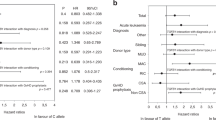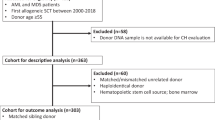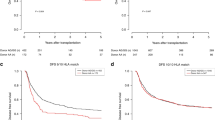Abstract
Hematopoietic stem cell transplantation (HSCT) with sibling donors (s.d.) is a life-saving intervention for patients with hematological malignancies. Numerous genetic factors have a role in transplant outcome. Several functional polymorphisms have been identified in TGF-β1 gene, such as single-nucleotide polymorphism (SNP) at +29C>T within exon 1. Two hundred and forty five patient/donor pairs who underwent a s.d. HSCT in our centers were genotyped for this SNP. In the myeloablative cohort, +29CC donors were associated with an increase in severe chronic GvHD (32% vs 16%, hazard ratio (HR) 9.0, P=0.02). Regarding survival outcomes, +29CC patients developed higher non relapse mortality (NRM) (1–5 years CC 28–32% vs TC/TT 7–10%; HR 5.1, P=0.01). Recipients of +29TT donors experienced a higher relapse rate (1–5 years TT 37–51% vs TC 19–25% vs CC 13%–19%; HR 2.4, P=0.01) with a decreased overall survival (OS) (1–5 years TT 69–50% vs TC/CC 77–69%; HR 1.9, P=0.05). Similar to previous myeloablative unrelated donors HSCT results, we confirmed that +29CC patients had higher NRM. In addition we found that +29TT donors might be associated with a higher relapse rate and lower OS. These results should be confirmed in larger series. Identification of these SNPs will allow personalizing transplant conditioning and immunosuppressant regimens, as well as assisting in the choice of the most appropriate donor.
This is a preview of subscription content, access via your institution
Access options
Subscribe to this journal
Receive 12 print issues and online access
$259.00 per year
only $21.58 per issue
Buy this article
- Purchase on Springer Link
- Instant access to full article PDF
Prices may be subject to local taxes which are calculated during checkout




Similar content being viewed by others
References
Gratwohl A . Risk assessment in haematopoietic stem cell transplantation. Best Pract Res Clin Haematol 2007; 20: 119–124.
National Comprehensive Cancer Network. NCCN Clinical Practice Guidelines in Oncology: Acute Lymphoblastic Leukemia, Acute Myeloid Leukemia, Myelodysplastic Syndromes. Fort Washington, PA, USA, 2015. https://www.nccn.org/professionals/physician_gls/f_guidelines.asp.
Aschan J . Risk assessment in haematopoietic stem cell transplantation: conditioning. Best Pract Res Clin Haematol 2007; 20: 295–310.
Petersdorf EW . Risk assessment in haematopoietic stem cell transplantation: histocompatibility. Best Pract Res Clin Haematol 2007; 20: 155–170.
Dickinson AM . Risk assessment in haematopoietic stem cell transplantation: pre-transplant patient and donor factors: non-HLA genetics. Best Pract Res Clin Haematol 2007; 20: 189–207.
Rocha V, Franco R, Porcher R, Bittencourt H, Silva WA Jr, Latouche A et al. Host defense and inflammatory gene polymorphisms are associated with outcome after HLA-identical sibling bone marrow transplantation. Blood 2002; 100: 3908–3918.
Chien J, Zhamg X, Fan W, Wang H, Zhao LP, Martin PJ et al. Evaluation of published single nucleotide polymorphism associated with acute GVHD. Blood 2012; 119: 5311–5319.
Cavet J, Dickinson A, Norden J, Taylor P, Jackson G, Middleton P . Interferon-γ and interleukin-6 gene polymorphism associated with graft-versus-host disease in HLA-matched sibling bone marrow transplantation. Blood 2001; 98: 1594–1600.
Blobe GC, Schiemann WP, Lodish HF . Role of transforming growth factor beta in human disease. N Engl J Med 2000; 342: 1350–1358.
Anscher MS, Peters WP, Reisenbichler H, Petros WP, Jirtle RL . Transforming growth factor beta as a predictor of liver and lung fibrosis after autologous bone marrow transplantation for advanced breast cancer. N Engl J Med 1993; 328: 1592–1598.
Bommireddy R, Doetschman T . TGFbeta1 and Treg cells: alliance for tolerance. Trends Mol Med 2007; 13: 492–501.
Li MO, Wan YY, Flavell RA . T cell-produced transforming growth factor-beta1 controls T cell tolerance and regulates Th1- and Th17-cell differentiation. Immunity 2007; 26: 579–591.
Li MO, Flavell RA . TGF-beta: a master of all T cell trades. Cell 2008; 134: 392–404.
Zheng SG, Gray JD, Ohtsuka K, Yamagiwa S, Horwitz DA . Generation ex vivo of TGF-beta-producing regulatory T cells from CD4+CD25- precursors. J Immunol 2002; 169: 4183–4189.
Letterio JJ . TGF-beta signaling in T cells: roles in lymphoid and epithelial neoplasia. Oncogene 2005; 24: 5701–5712.
Nakamura K, Kitani A, Strober W . Cell contact-dependent immunosuppression by CD4(+)CD25(+) regulatory T cells is mediated by cell surface-bound transforming growth factor beta. J Exp Med 2001; 194: 629–644.
Savage ND, de Boer T, Walburg KV, Joosten SA, van Meijgaarden K, Geluk A et al. Human anti-inflammatory macrophages induce Foxp3+ GITR+ CD25+ regulatory T cells, which suppress via membrane-bound TGFbeta-1. J Immunol 2008; 181: 2220–2226.
Perlman D, Halvorson HO . A putative signal peptidase recognition site and sequence in eukaryotic and prokaryotic signal peptides. J Mol Biol 1983; 167: 391–409.
Derynck R, Jarrett JA, Chen EY, Eaton DH, Bell JR, Assoian RK et al. Human transforming growth factor-beta complementary DNA sequence and expression in normal and transformed cells. Nature 1985; 316: 701–705.
Assoian RK, Komoriya A, Meyers CA, Miller DM, Sporn MB . Transforming growth factor-beta in human platelets. Identification of a major storage site, purification, and characterization. J Biol Chem 1983; 258: 7155–7160.
Annes JP, Munger JS, Rifkin DB . Making sense of latent TGF beta activation. J Cell Sci 2003; 116 (Pt 2): 217–224.
Suthanthiran M, Li B, Song J, Ding R, Sharma VK, Schwartz JE et al. Transforming growth factor-ß1 hyperexpression in African-American hypertensives: a novel mediator of hypertension and/or target organ damage. Proc Natl Acad Sci USA 2000; 97: 3479–3484.
Awad MR, El-Gamel A, Hasleton P, Turner DM, Sinnott PJ, Hutchinson IV . Genotypic variation in the transforming growth factor-beta1 gene: association with transforming growth factor-beta1 production, fibrotic lung disease, and graft fibrosis after lung transplantation. Transplantation 1998; 66: 1014–1020.
Gewaltig J, Mangasser-Stephan K, Gartung C, Biesterfeld S, Gressner AM . Association of polymorphisms of the transforming growth factor-beta1 gene with the rate of progression of HCV-induced liver fibrosis. Clin Chim Acta 2002; 316: 83–94.
Mak JC, Leung HC, Sham AS, Mok TY, Poon YN, Ling SO et al. Genetic polymorphisms and plasma levels of transforming growth factor-beta(1) in Chinese patients with tuberculosis in Hong Kong. Cytokine 2007; 40: 177–182.
Ziv E, Cauley J, Morin PA, Saiz R, Browner WS . Association between the T29—>C polymorphism in the transforming growth factor beta1 gene and breast cancer among elderly white women: the Study of Osteoporotic Fractures. JAMA 2001; 285: 2859–2863.
Dunning AM, Ellis PD, McBride S, Kirschenlohr HL, Healey CS, Kemp PR et al. A transforming growth factorbeta1 signal peptide variant increases secretion in vitro and is associated with increased incidence of invasive breast cancer. Cancer Res 2003; 63: 2610–2615.
Yamada Y, Miyauchi A, Goto J, Takagi Y, Okuizumi H, Kanematsu M et al. Association of a polymorphism of the transforming growth factor-beta1 gene with genetic susceptibility to osteoporosis in postmenopausal Japanese women. J Bone Miner Res 1998; 13: 1569–1576.
Berndt SI, Huang WY, Chatterjee N, Yeager M, Welch R, Chanock SJ et al. Transforming growth factor beta 1 (TGFB1) gene polymorphisms and risk of advanced colorectal adenoma. Carcinogenesis 2007; 28: 1965–1970.
Nikolova PN, Ivanova MI, Mihailova SM, Myhailova AP, Baltadjieva DN, Simeonov PL et al. Cytokine gene polymorphism in kidney transplantation—impact of TGF-beta 1, TNF-alpha and IL-6 on graft outcome. Transpl Immunol 2008; 18: 344–348.
Berro M, Mayor N, Maldonado-Torres H, Cooke L, Kusminsky G, Marsh SG et al. Association of functional polymorphism of the transforming growth factor B1 gene with survival and graft-versus-host disease after unrelated donor hematopoietic stem cell transplantation. Haematologica 2010; 95: 276–283.
Hattori H, Matsuzaki A, Suminoe A, Ihara K, Nagatoshi Y, Sakata N et al. Polymorphisms of transforming growth factor-beta1 and transforming growth factor-beta1 type II receptor genes are associated with acute graft-versus-host disease in children with HLA-matched sibling bone marrow transplantation. Bone Marrow Transplant 2002; 30: 665–671.
Leffell MS, Vogelsang GB, Lucas DP, Delaney NL, Zachary AA . Association between TGF-beta expression and severe GVHD in allogeneic bone marrow transplantation. Transplant Proc 2001; 33: 485–486.
Noori-Daloii M, Rashidi-Nezhad A, Izadi P, Hossein-Nezhad A, Sobhani M, Derakhshandeh-Peykar P et al. Transforming growth factor-ß1 codon 10 polymorphism is associated with acute GVHD after allogeneic BMT in Iranian population. Ann Transplant 2007; 12: 5–10.
Perrey C, Turner SJ, Pravica V, Howell WM, Hutchinson IV . ARMS-PCR methodologies to determine IL-10, TNF-alpha, TNF-beta and TGF-beta 1 gene polymorphisms. Transpl Immunol 1999; 7: 127–128.
Melenhorst JJ, Tian X, Xu D, Sandler NG, Scheinberg P, Biancotto A et al. Cytopenia and leukocyte recovery shape cytokine fluctuation after myeloablative allogeneic hematopoietic stem cell transplantation. Haematologica 2012; 97: 867–873.
Chang L, Frame D, Braun T, Gatza E, Hanauer DA, Zhao S et al. Engraftment syndrome following allogeneic hematopoietic cell transplantation predicts poor outcomes. Biol Blood Marrow Transplant 2014; 20: 1407–1417.
Robb R, Lineburg K, Kuns R, Wilson YA, Raffelt NC, Olver SD et al. Identification and expansion of highly suppressive CD8+FOXP3+ regulatory T cells after experimental allogeneic bone marrow transplantation. Blood 2012; 119: 5898–5908.
Woolfrey A, Lee SJ, Gooley T, Malkki M, Martin PJ, Pagel JM et al. HLA-allele matched unrelated donors compared to HLA-matched sibling donors: role of cell source and disease risk category. Biol Blood Marrow Transplant 2010; 16: 1382–1387.
Banovic T, MacDonald K, Morris E, Rowe V, Kuns R, Don A et al. TGF-ß in allogeneic stem cell transplantation: friend or foe. Blood 2005; 106: 2206–2214.
Li Q, Zhai Z, Xu X, Shen Y, Zhang A, Sun Z et al. Decrease of CD4+CD25+ regulatory T cells and TGF-β at early immune reconstitution is associated to the onset and severity of graft-versus-host disease following allogeneic haematogenesis stem cell transplantation. Leuk Res 2010; 34: 1158–1168.
Laguila Visenteiner J, Rocha Lieber S, Lopes Persoli L, Vigorito AC, Aranha FJ, de Brito Eid KA et al. Serum cytokine levels and acute graft-versus-host disease after HLA/identical hematopoietic stem cell transplantation. Exp Hematol 2003; 31: 1044–1050.
Niu YY, Ma LM, Zhou Y, Ren R . Relationship between CD4(+)CD25(+) regulatory T cell, IL2, TGF-beta and acute graft-versus-host disease after allogeneic hematopoietic stem cell transplantation. Zhongguo Shi Yan Xue Ye Xue Za Zhi 2010; 18: 735–739.
Liem L, Fibbe W, van Houwelingen H, Goulmy E . Serum transforming growth factor-beta 1 levels in bone marrow transplant recipients correlate with blood cell counts and chronic graft-versus-host disease. Transplantation 1999; 67: 59–65.
Kyrcz-Krzemien S, Helbig G, Zielinska P, Markiewicz M . The kinetics of mRNA transforming growth factor beta1 expression and its serum concentration in graft-versus-host disease after allogeneic hemopoietic stem cell transplantation for myeloid leukemias. Med Sci Monit 2011; 17: CR322–CR328.
Ellison C, Lissitsyn Y, Gheorghiu L, Gartner J . Immunomodulatory effects of palifermin (recombinant human keratinocyte growth factor) in an SLE-like model of chronic graft-versus-host disease. Scand J Immunol 2012; 75: 69–76.
Xiao H, Cao W, Lai X, Luo Y, Shi J, Tan Y et al. Immunosuppressive cytokine gene polymorphism and outcome after related and unrelated hematopoietic cell transplantation in Chinese population. Biol Blood Marrow Transplant 2011; 17: 542–549.
Zhang L, Mao L, Xu J . Transforming growth factor-β1 polymorphisms and graft-versus-host disease risk: a meta-analysis. Oncotarget 2016; 7: 2455–2461.
Arrieta-Bolaños E, Mayor N, Marsh SGE, Madrigal JA, Apperley JF, Kirkland K et al. Polymorphism in TGFB1 is associated with worse non-relapse mortality and overall survival after stem cell transplantation with unrelated donors. Haematologica 2016; 101: 382–390.
Sorror ML, Maris MB, Storb R, Baron F, Sandmaier BM, Maloney DG et al. Hematopoietic cell transplantation (HCT)-specific comorbidity index: a new tool for risk assessment before allogeneic HCT. Blood 2005; 106: 2912–2919.
Acknowledgements
We thank the transplant centers physicians who worked in the data collection. To Neema Mayor for her idea.
Author information
Authors and Affiliations
Corresponding author
Ethics declarations
Competing interests
The authors declare no conflict of interest.
Rights and permissions
About this article
Cite this article
Berro, M., Palau Nagore, M., Rivas, M. et al. Transforming growth factor-β1 functional polymorphisms in myeloablative sibling hematopoietic stem cell transplantation. Bone Marrow Transplant 52, 739–744 (2017). https://doi.org/10.1038/bmt.2016.355
Received:
Revised:
Accepted:
Published:
Issue Date:
DOI: https://doi.org/10.1038/bmt.2016.355
This article is cited by
-
Investigation of TGFB1 −1347C>T variant as a biomarker after allogeneic hematopoietic stem cell transplantation
Bone Marrow Transplantation (2020)



